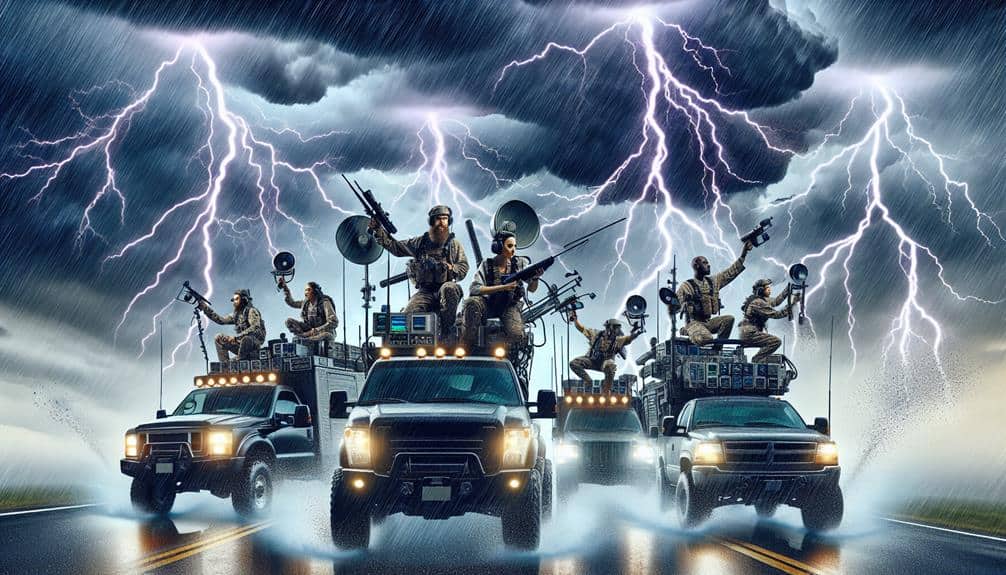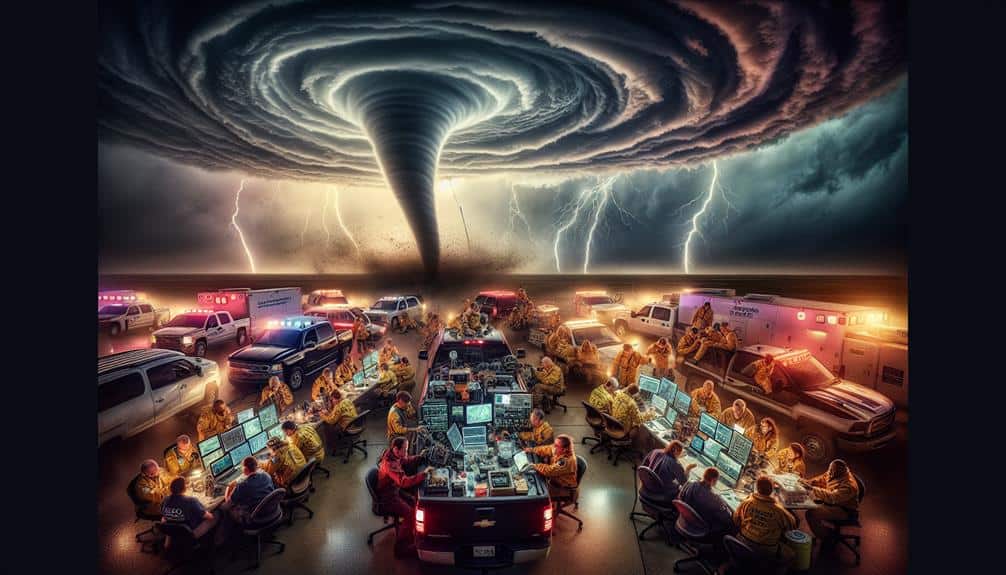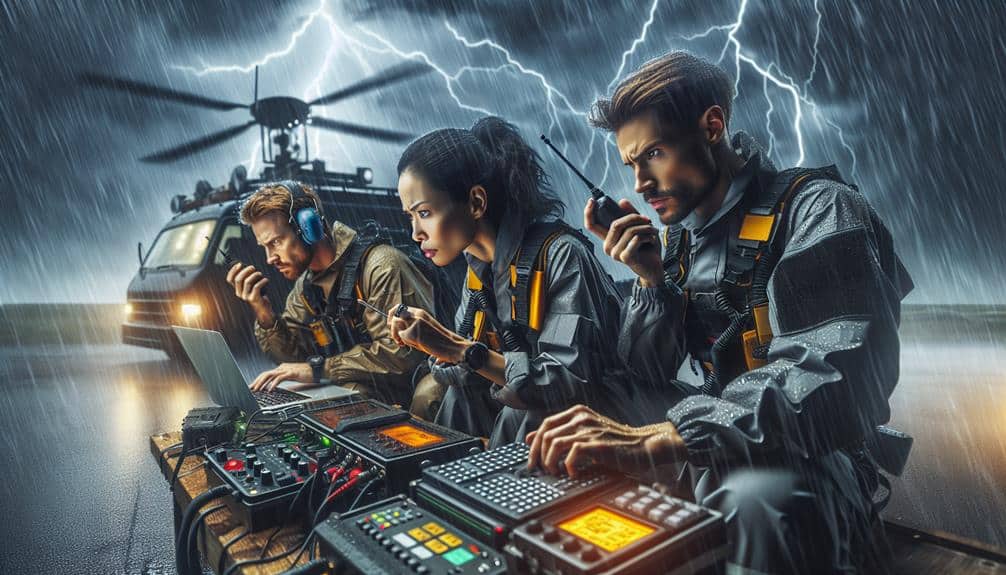Efficient storm chasing coordination requires us to set up clear communication channels to share real-time updates, utilize advanced weather technology for precise tracking, and implement strict safety protocols to protect our team. We must also coordinate with local authorities to gain situational insights and optimize team mobility and equipment for seamless operations. By focusing on these areas, we can make informed decisions quickly and keep our team safe while effectively chasing storms. For detailed information on each tip, keep exploring.
Key Points
- Establish clear communication channels for real-time updates and seamless team coordination.
- Utilize advanced weather technology to enhance predictive capabilities and monitor storm developments accurately.
- Implement comprehensive safety protocols, including PPE and emergency response training.
- Coordinate closely with local authorities for situational awareness and optimized route planning.
Establish Clear Communication Channels
To guarantee effective storm chasing coordination, we must establish clear communication channels that facilitate real-time information exchange. This is essential for ensuring that our team coordination remains seamless and efficient. By setting up robust communication networks, we can share critical updates instantly, allowing us to make informed decisions quickly.
Our primary objective should be to utilize tools that enable instant messaging, voice communication, and data sharing. These tools will keep us connected and well-informed, even in remote areas. A well-coordinated team can respond to emergencies more effectively, minimizing risks and maximizing our chances of success.
We should also establish a hierarchy for communication to make sure that information flows smoothly. Each team member must know their role and the designated point of contact for specific types of information. This structured approach will prevent confusion and ensure that everyone receives the necessary updates promptly.
In emergency response scenarios, it's important to have backup communication systems. Redundancy in our communication channels will safeguard against potential failures, ensuring continuous connectivity. Our commitment to clear and efficient communication will enhance our storm chasing operations, enabling us to pursue our passion with confidence and freedom.
Utilize Advanced Weather Technology
We leverage cutting-edge weather technology to enhance our ability to predict and track storm patterns with high accuracy. By integrating real-time tracking and forecasting tools, we can anticipate storm developments and make informed decisions on the fly.
Satellite imagery provides us with a detailed view of atmospheric conditions, enabling us to monitor cloud formations and storm trajectories from a macro perspective. This bird's-eye view is essential for identifying potential storm cells before they develop into severe weather events.
Radar technology complements satellite imagery by offering more detailed data. With radar, we can detect precipitation intensity, wind speeds, and rotation within storm systems. This level of detail allows us to pinpoint the most active parts of a storm, ensuring we focus our efforts where they're most needed.
The combination of these technologies forms a robust framework for storm chasing, enhancing our capabilities and improving our success rates.
Access to such advanced tools empowers us to operate with a level of precision that was previously unattainable. By staying ahead of the storm through real-time tracking and accurate forecasting, we maximize our chances of capturing crucial data while minimizing unnecessary risks.
Implement Safety Protocols
While advanced weather technology enhances our predictive and tracking capabilities, implementing rigorous safety protocols is vital to guarantee our team's well-being during storm chasing operations. Effective safety measures start with thorough training. We must make sure every team member is knowledgeable about the risks and knows how to respond to various emergency scenarios.
We equip our vehicles with essential safety gear, including first aid kits, fire extinguishers, and communication devices. Maintaining constant communication is essential for quick emergency response and to keep everyone updated on changing weather conditions. Each vehicle should also be GPS-enabled to track locations in real-time, allowing us to respond swiftly if a member encounters trouble.
Personal protective equipment (PPE) is another crucial aspect of our safety measures. Helmets, sturdy boots, and weather-resistant clothing are non-negotiable. We also establish a clear chain of command to streamline decision-making and ensure rapid responses to emergencies.
Regular safety drills and debriefings post-chase help reinforce our protocols and improve them continuously.
Coordinate With Local Authorities
Frequently, working closely with local authorities plays a vital role in guaranteeing the success and safety of our storm chasing operations. This partnership facilitates real-time information exchange, improving our situational awareness and decision-making processes. By maintaining direct lines of communication with emergency response teams, we can proactively address potential hazards and align our activities with official safety protocols.
Engaging with local communities is equally essential. Building a rapport with residents and local officials allows us to tap into area-specific knowledge that can be invaluable during storm tracking. Community engagement ensures that our presence is understood and supported, reducing disruptions and fostering a collaborative environment.
Furthermore, local authorities can grant access to restricted areas and provide timely updates on road conditions, evacuation orders, and emergency response plans. This information is essential for optimizing our routes and ensuring we steer clear of danger zones. By incorporating local insights into our strategic planning, we can make more informed decisions that enhance both our safety and operational efficiency.
In essence, our collaboration with local authorities and interaction with the community not only improves our data accuracy but also strengthens our overall preparedness. This proactive approach is essential for carrying out successful and safe storm chasing missions.
Optimize Team Mobility and Equipment

Building on our collaboration with local authorities, our next focus is on optimizing team mobility and equipment to guarantee utmost efficiency and safety during storm chasing operations.
A well-coordinated team must maintain seamless communication and make sure all equipment is in prime condition.
First, let's address team communication. We should equip every vehicle with reliable two-way radios and GPS systems. These tools will allow us to share real-time updates and coordinate movements effectively. Clear communication protocols are essential to prevent misunderstandings and make sure everyone knows their role and location at all times.
Next, equipment maintenance is vital. Regular inspections of radar systems, cameras, and meteorological instruments should be mandatory. Any malfunctioning equipment can compromise our mission and safety. We must establish a routine maintenance schedule and immediately address any issues that arise.
Additionally, vehicle readiness is non-negotiable. Our vehicles should be equipped with emergency supplies, including first aid kits, spare tires, and repair tools. Fuel levels should be regularly checked to avoid unexpected delays.
Frequently Asked Questions
What Qualifications Should a Storm Chaser Possess?
Chasing storms is like dancing with chaos. We need experience, expertise, proper certification, and a strong educational background. Essential skills and rigorous training guarantee we're not just thrill-seekers but informed guardians of nature's wild expressions.
How Do Storm Chasers Find Funding for Their Expeditions?
To secure funding for our storm chasing expeditions, we explore sponsorship opportunities and launch crowdfunding campaigns. This strategy allows us to maintain independence while leveraging community support and brand partnerships to cover our costs effectively.
Are There Specific Regions More Prone to Severe Storms?
Isn't it ironic that Tornado Alley, despite being infamous, is still a magnet for storm chasers? Regions prone to Hurricanes, frequent Lightning Strikes, and Typhoon Season offer dynamic, albeit risky, opportunities for our expeditions.
What Are Common Misconceptions About Storm Chasing?
Common misconceptions about storm chasing include underestimating necessary safety precautions and over-dramatizing events due to media portrayal. We must prioritize accurate information and responsible practices to guarantee our safety and freedom when chasing storms.
How Do Storm Chasers Manage the Psychological Stress of Their Work?
We weather the storm's fury with strong support systems and effective coping mechanisms. Stress management is essential; we prioritize our mental health through regular debriefs, peer support, and mindfulness practices, ensuring we stay resilient and grounded.


